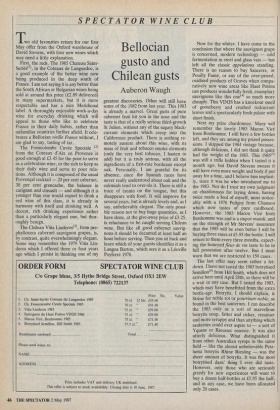SPECTATOR WINE CLUB
Bellocian gusto and Chilean gusts
Auberon Waugh
Two old favourites return for our first May offer from the Oxford warehouse of David Stevens, with four new wines which may need a little explanation.
First, the reds. The 1985 Chateau Saint- Series(1), in the Coteaux de Languedoc, is a good example of the better wine now being produced in the deep south of France. I am not saying it is any better than the South African or Bulgarian wines being sold at around this price (£2.89 delivered) in many supermarkets, but it is more respectable and has a nice Meridional label. A thoroughly enjoyable work-a-day wine for everyday drinking which will appeal to those who like to celebrate France in their daily habits, rather than unfamiliar countries further afield. It cele- brates a Bellocian vieille France without, I am glad to say, tasting of tar. The Fonscolombe Cuvee Speciale (2) from the Coteaux d'Aix en Provence is good enough at £3.45 for the poor to serve as a celebration wine, or the rich to keep as their daily wine and serve to poor rela- tions. Although it is composed of the usual Provençal cocktail — 20 per cent cabernet, 30 per cent grencache, the balance in carignan and cinsault — and although it is younger than one would expect to drink a red wine of this class, it is already in harmony with itself and drinking well. A decent, rich drinking experience rather than a particularly elegant one, but thor- oughly benign. The Chilean Villa Linderos(3), from pre- phylloxera cabernet sauvignon grapes, is, by contrast, quite overwhelmingly elegant. Some may remember the 1979 Viria Lin- deros which I offered three or four years ago which I persist in thinking one of my greatest discoveries. Other will still have some of the 1982 from last year. This 1983 is already a marvel. Great gusts of pure cabernet fruit hit you in the nose and the taste is that of a really serious third-growth St Julien, without any of the sugary black- currant elements which creep into the Californian product. There is nothing re- motely austere about this wine, with its mass of fruit and tobacco smoke elements (only the very best tobacco, I hasten to add) but it is truly serious, with all the ingredients of a first-rate bordeaux except oak. Personally, I am grateful for its absence, since the Spanish races have never really understood about oak and the colonials tend to over-do it. There is still a trace of tannin on the tongue, but this disappears with food. It will improve for several years, but.is already lovely and, as I say, unbelievably elegant. The only possi- ble reason not to buy huge quantities, as I have done, at the give-away price of £3.25, is reluctance to be caught serving Chilean wine. But like all good cabernet sauvig- nons it should be decanted at least half an hour before serving. Then you sit back and learn which of your guests identifies it as a Langoa Barton, which sees it as a Leoville Poyferre 1978. Now for the whites. I have come to the conclusion that where the sauvignon grape is concerned, modern technology — cold fermentation in steel and glass vats — has left all the classic appelations standing. There is no reason to buy Sancerre, or Pouilly Fume, or any of the over-priced, oxidised products of Graves when compa- ratively new wine areas like Haut Poitou can producer wonderfully fresh, examplary sauvignons like this one(4) so much more cheaply. This VDQS has a knockout smell of gooseberry and crushed redcurrant leaves and a spectacularly fresh palate with short finish.
Next my prize chardonnay. Many will remember the lovely 1983 Macon Vire from Bonhomme. I still have a few bottles left, and they are among my prized posses- sions. I skipped the 1984 vintage because, although delicious, I did not think it quite had the weight of the 1983. This 1985(5) was still a trifle hidderi when I tasted it a month ago, but David Stevens swears it will have even more weight and body if put away for a time, and I believe him implicit- ly, since it was he who introduced me to the 1983. Nor do I trust my own judgment on chardonnays for laying down, having twice made a fool of myself, most notice- ably with a 1978 Puligny from Chanson which now tastes of pure cardboard. However, the 1983 Macon Vire from Bonhomme was and is a stupor mundi, and on the strength of Mr Stevens' assurance that the 1985 will be even better I will be buying three cases at £5.95 the bottle. I will return to them every three months, expect- ing the honeyed fleur de yin taste to be in full possession after twelve. But I must warn that we are restricted to 150 cases.
The last offer may seem rather a let- down. I have not tasted the 1985 botrytised Seinillon(6) from Hill Smith, which does not arrive here until April 28th, so there will be a wait in any case. But I tasted the 1983, which may have benefitted from the extra bottle-age. Botrytis, I should explain, is Strine for noble rot or pourriture noble, as found in the best sauternes. I can describe the 1983 only as a sort of marvellous botrytis soup, fatter and richer, creamier and more syruppy and than anything which sauternes could ever aspire to — a sort of Yquem or Rieussec essence. It was also utterly delicious. What distinguished it from other Australian syrups in the same field — like the almost unbelievable Peta- luma botrytis Rhine Riesling — was the sheer amount of botrytis. It was the most botrytised darn' thing I ever did taste. However, only those who are seriously greedy for new experiences will want to buy a dozen half-bottles at £5.95 the half, and in any case, we have been allocated only 20 cases.


















































 Previous page
Previous page